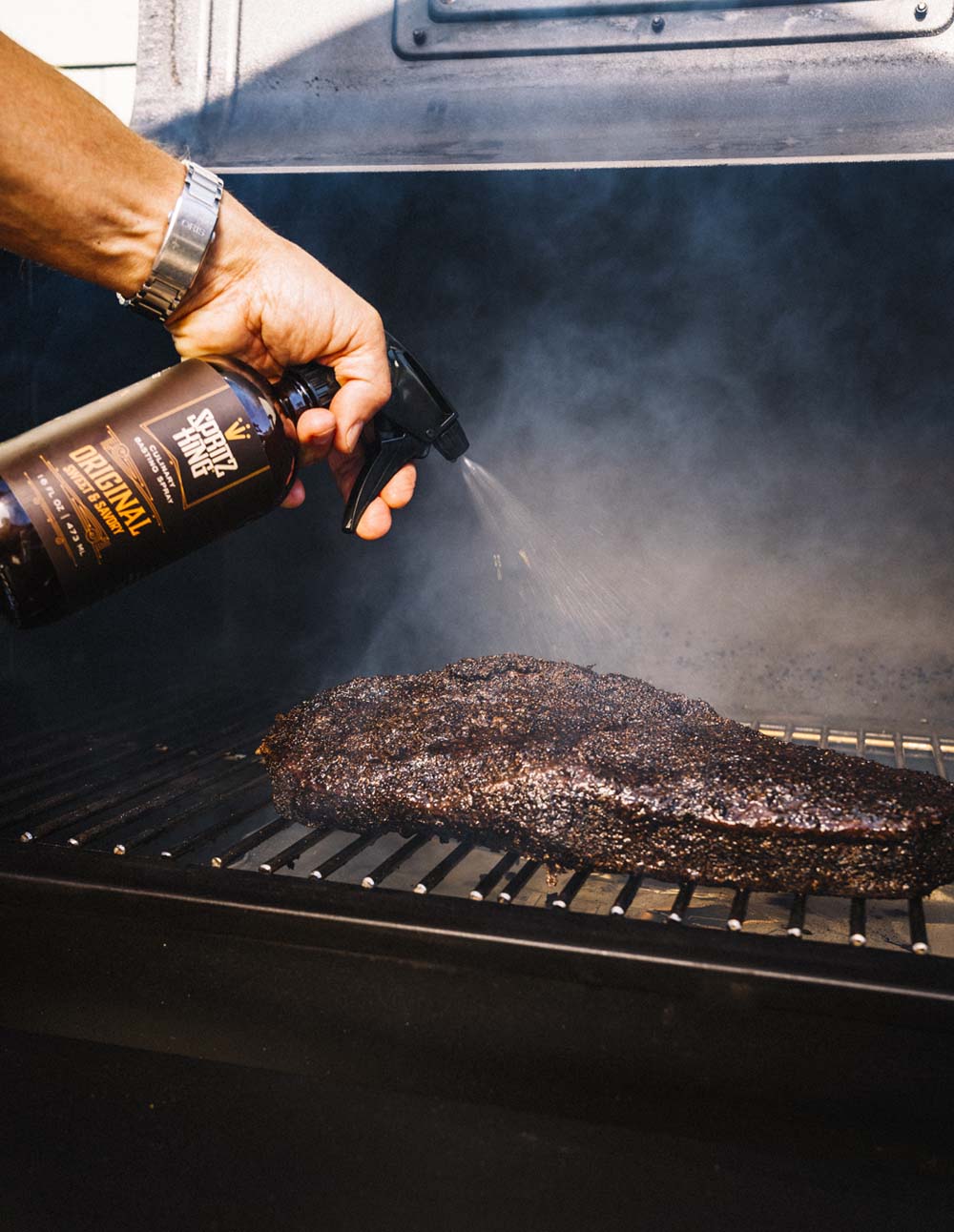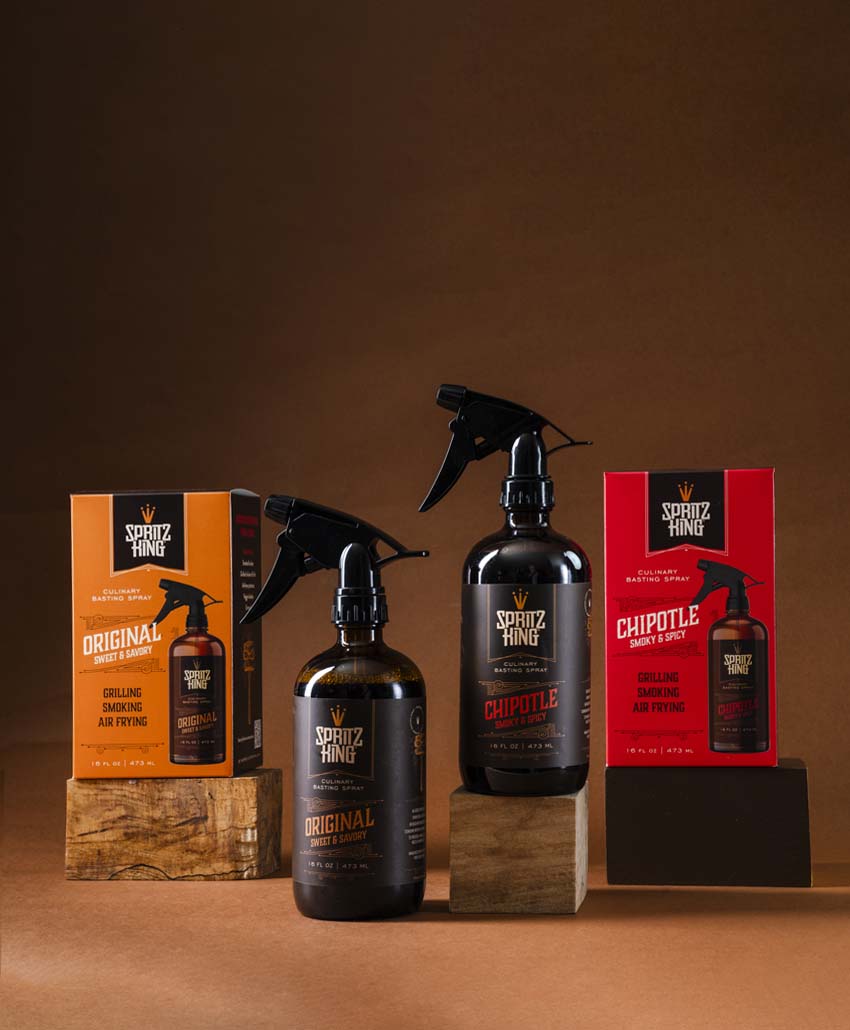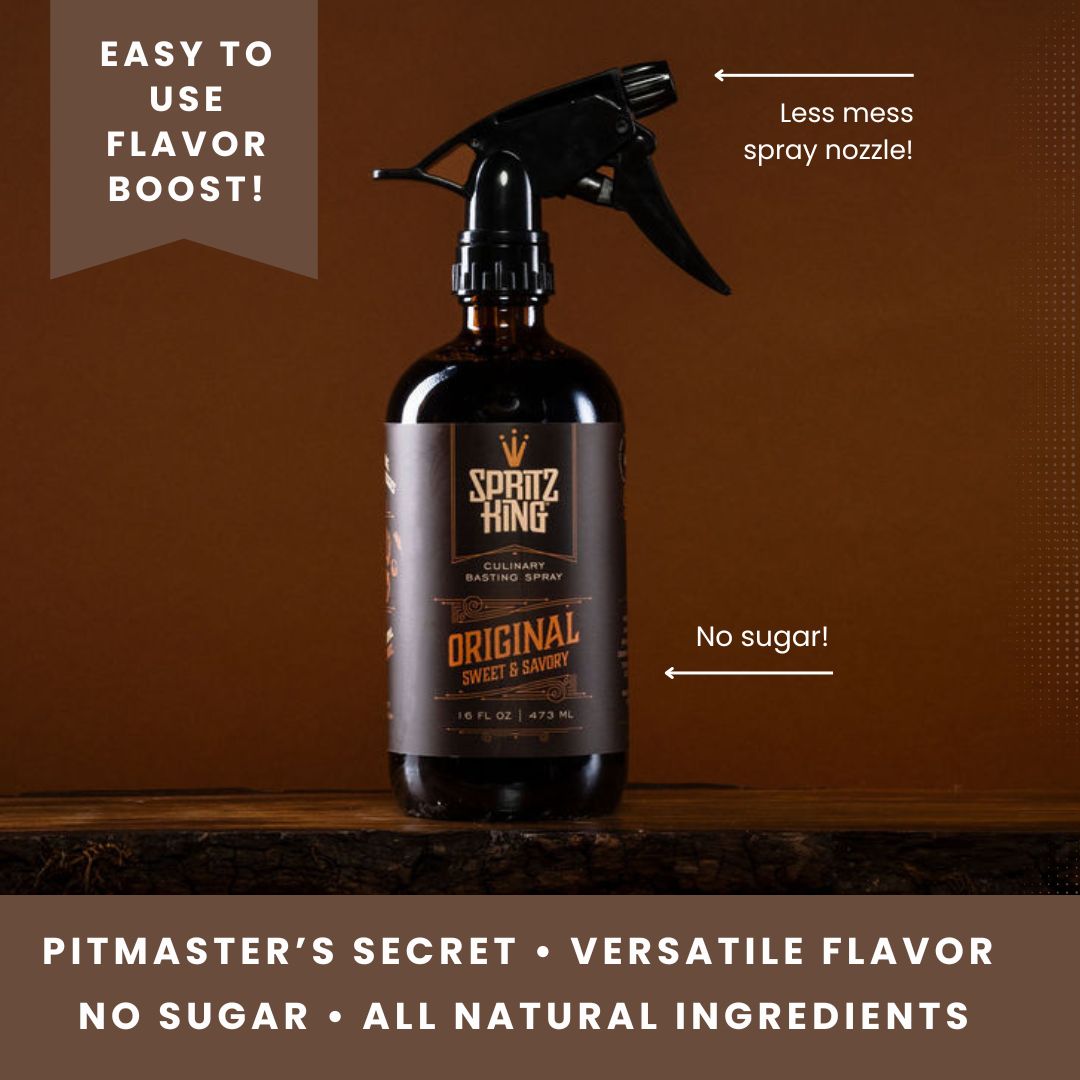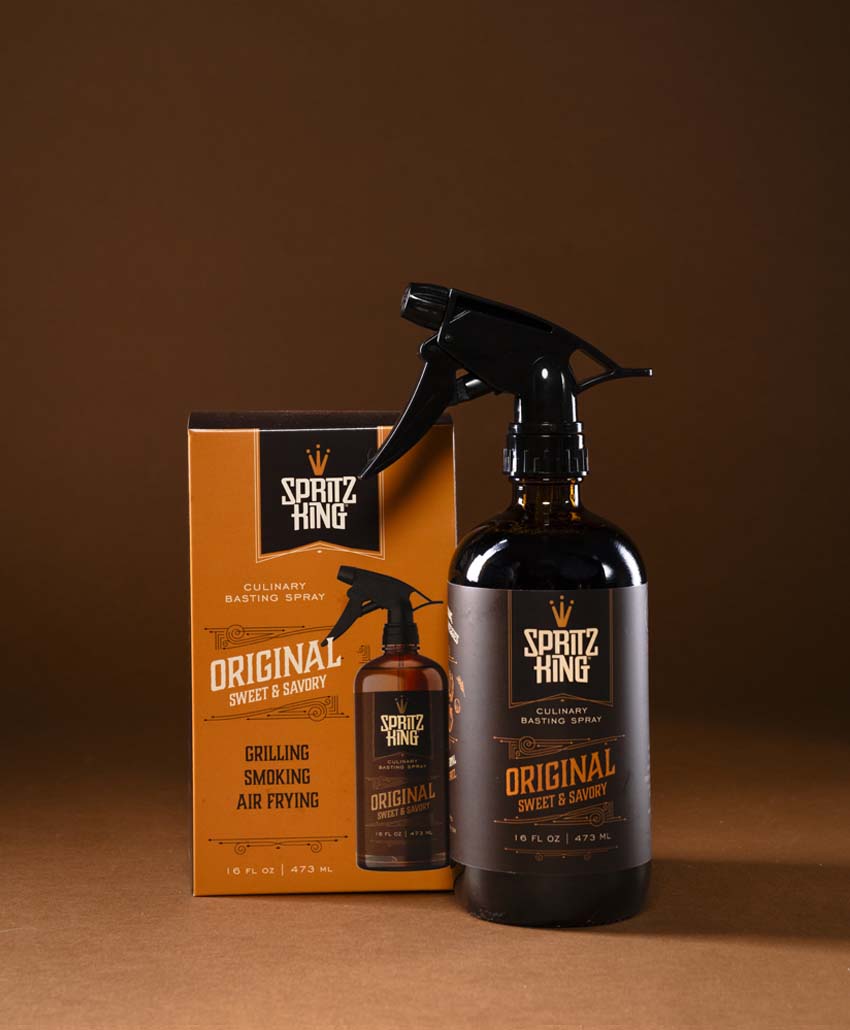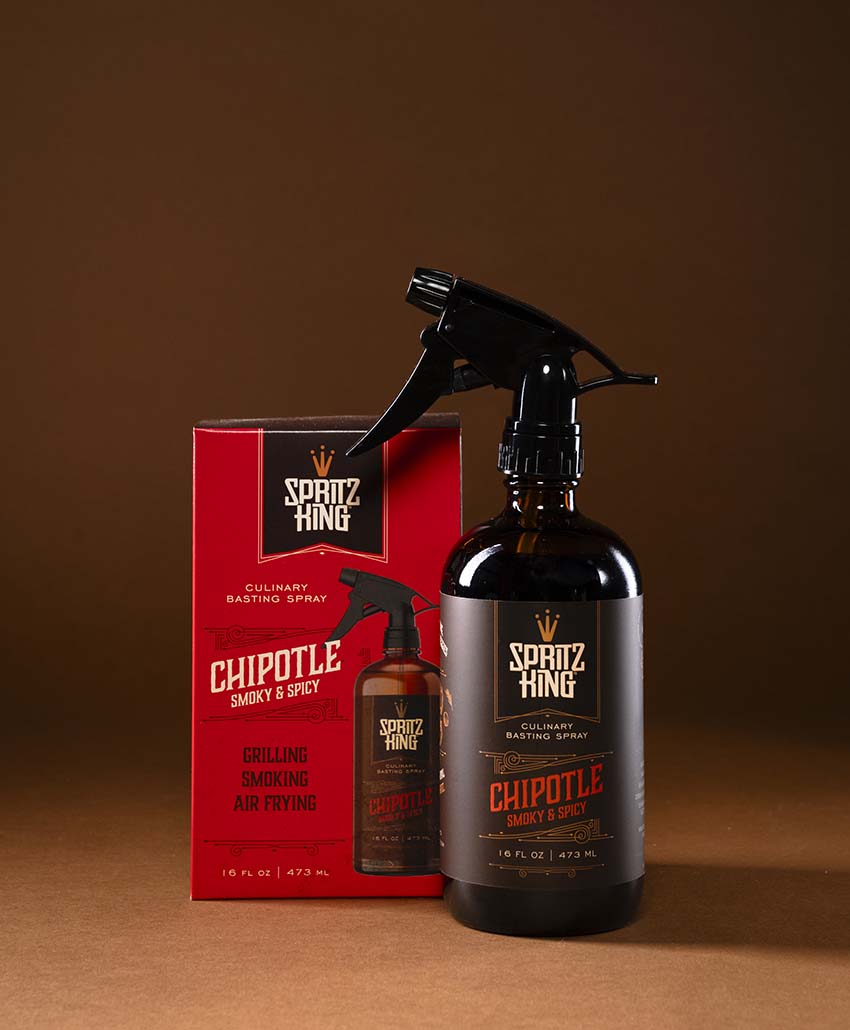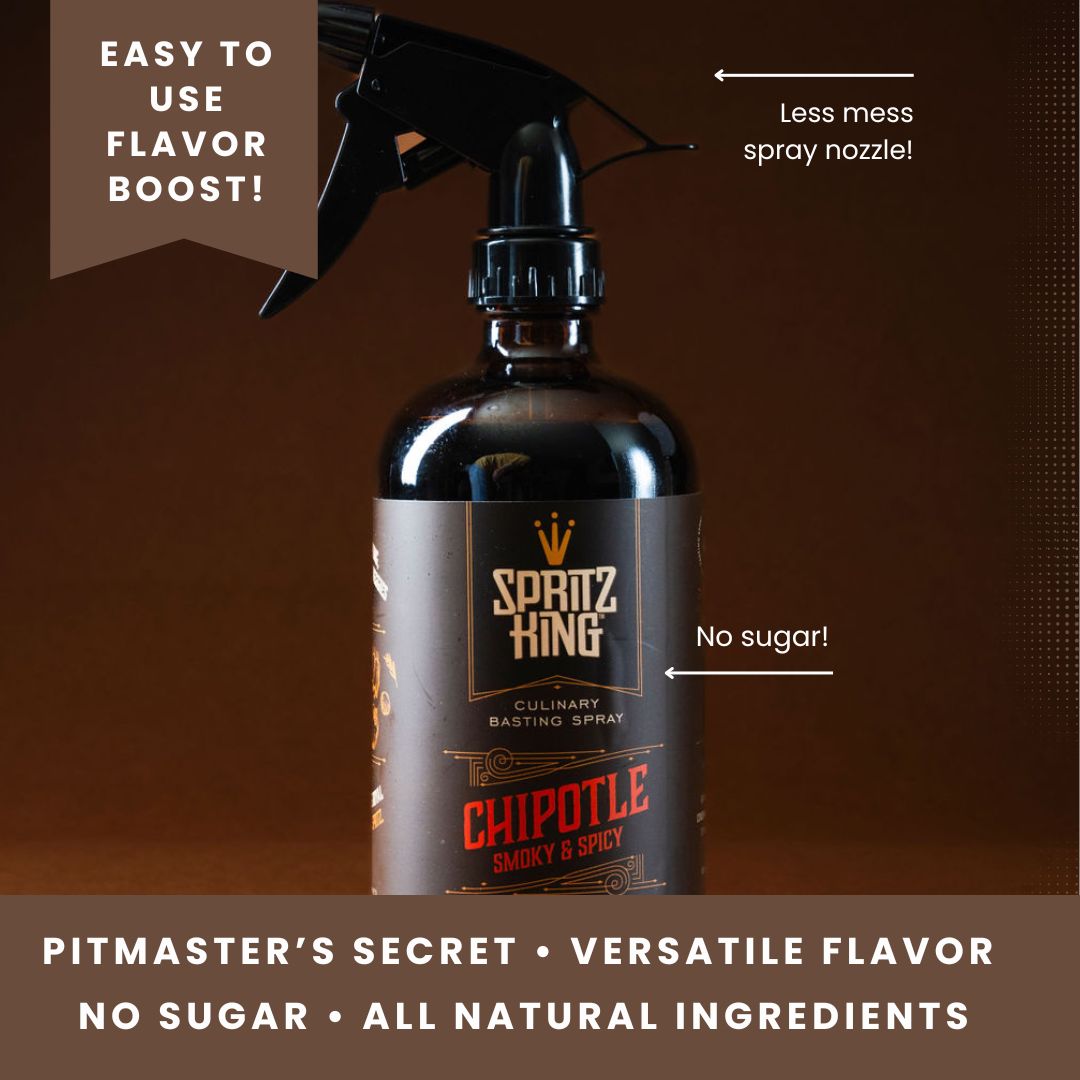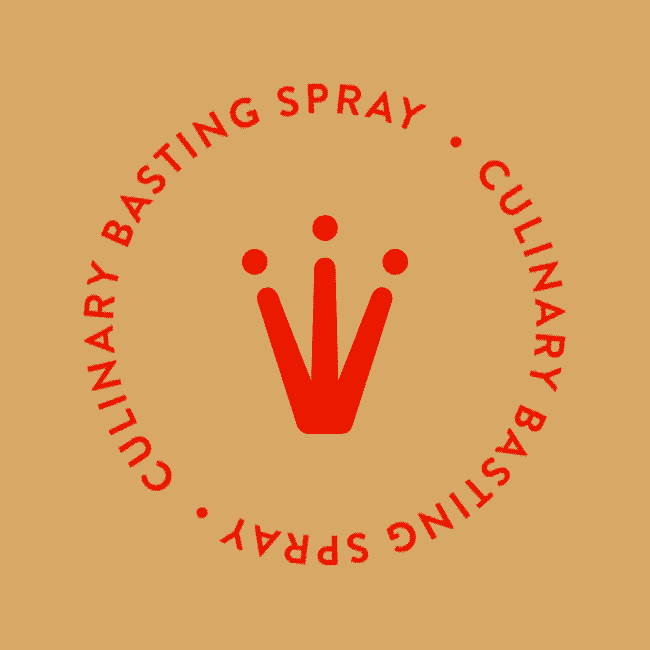Introduction to Spritzing Meat & Vegetables
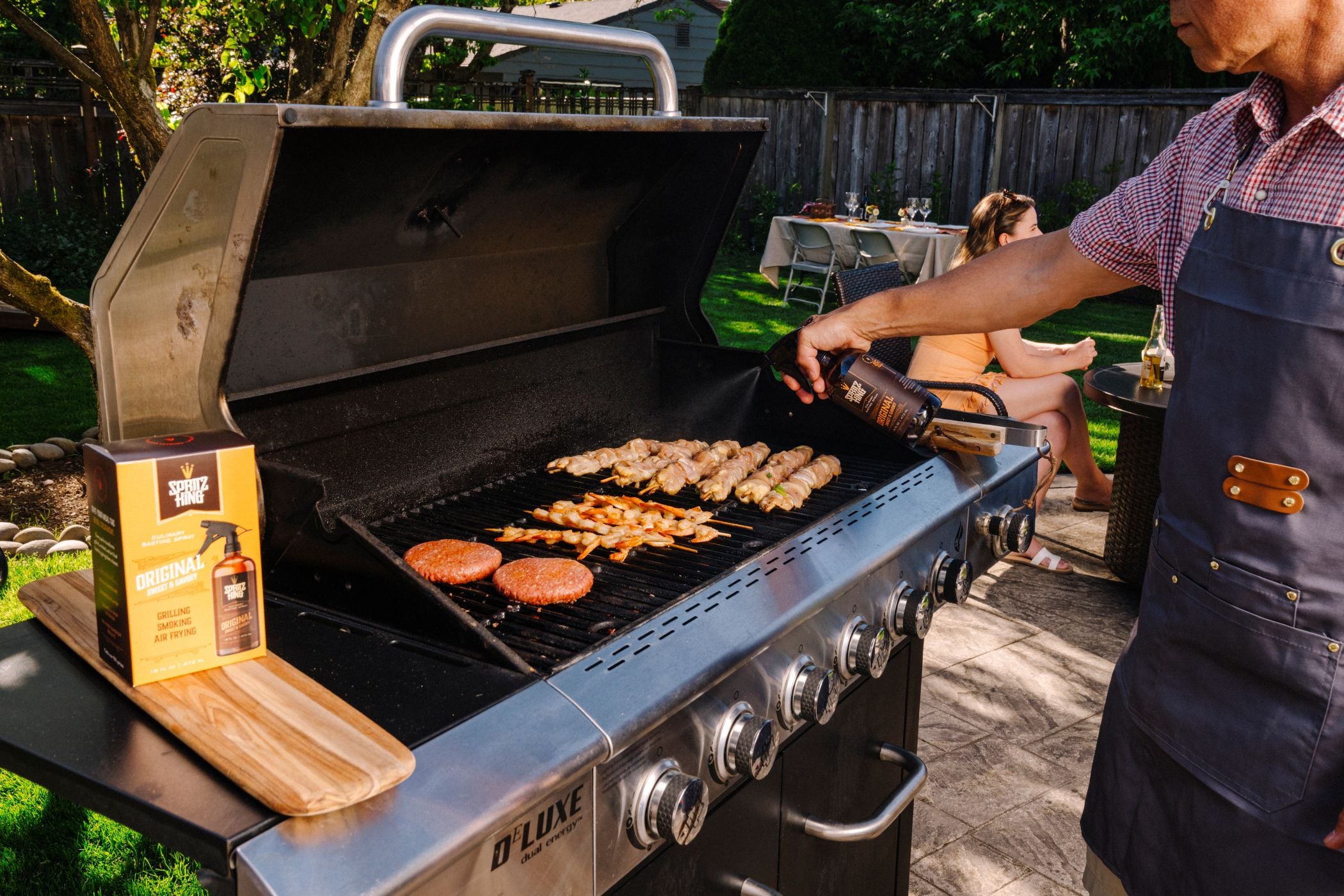
Spritzing is one of the lesser-known, but highly effective techniques in grilling and smoking. Spritzing involves periodically spraying a flavored liquid on meat while it’s cooking, helping to maintain moisture, enhance flavor, and create a flavorful crust. If you’ve seen pitmasters regularly spraying their meats during a long cook, you might have wondered what the purpose is. This guide will break down everything you need to know about spritzing, from the basics to advanced techniques.
What is spritzing, and why is it essential for BBQ, air fryer, and smoker recipes?
Spritzing refers to the practice of spraying a liquid—typically water or a flavored solution—on meat during the cooking process. The primary goal is to add moisture, enhance flavor absorption, help maintain temperature and promote a crispy, flavorful bark (the outer layer of the meat). Spritzing can also help to influence the color and texture of the crust, contributing to a more visually appealing and delicious finished product. Spritz King’s products take spritzing to a new level by perfecting the ratios of ingredients to ensure they maximize the crisp exterior while sealing in moisture and enhancing flavors.
Historical roots of spritzing in traditional barbecue methods.
The historical roots of spritzing in barbecue methods can be traced back to the practice of basting meats with liquids to enhance flavor and moisture during slow cooking. The tradition likely has origins in various cultures that used low, indirect heat to cook large cuts of meat over extended periods, particularly in the American South. Early barbecue techniques in the U.S. involved wrapping meats in leaves or covering them with wet cloths to retain moisture. Over time, cooks began using brushes or spray bottles to apply liquids such as vinegar, apple juice, or beer to keep the meat moist, develop a flavorful crust, and balance the effects of smoking. This technique became more refined as barbecue styles evolved, especially in competitive cooking, where spritzing became a crucial step in achieving the perfect texture and flavor profile on smoked meats like ribs and pork butts. Today, spritzing continues to be a popular method in both home and professional barbecue, adding depth to the flavors and improving the overall texture of the finished product.
The Science Behind Spritzing
Spritzing during barbecue cooking involves periodically spraying the meat with a liquid, typically a mixture of water, apple cider vinegar, or juice. This special formulation of amino acids and sugars helps to maintain moisture, enhance flavor, and promote the formation of a flavorful bark while preventing the meat from drying out during the long cooking process.
Spritzing plays a crucial role in temperature control during long cooking processes like smoking meats by adding moisture to the surface, which helps regulate the temperature, prevents excessive drying, and promotes the development of a flavorful, tender bark.
Acidic liquids, such as vinegar, play a significant role in tenderizing proteins during cooking. When an acid like vinegar is applied to meat, it works by breaking down the muscle fibers and connective tissues, specifically collagen, which is responsible for the toughness of certain cuts. The acid causes the proteins in the meat to denature, meaning they unravel and lose their tight structure. This makes the meat softer and more tender. Additionally, the acid helps to retain moisture within the meat by altering the protein’s ability to retain water, resulting in a juicier texture. However, the effectiveness of vinegar in tenderizing depends on the concentration of the acid and the length of exposure, as prolonged marinating can sometimes result in an overly soft or mushy texture. For best results, vinegar is often used in combination with other ingredients like oils or seasonings, creating a balanced marinade that enhances flavor while tenderizing proteins.
Key considerations when choosing spritzing liquids: When creating a barbecue spritz, key considerations include selecting liquids that complement the flavor of the meat and enhance the cooking process. Common choices include apple cider vinegar for acidity, which helps tenderize the meat and balance richness, or fruit juices like apple or pineapple for a hint of sweetness. Water is often used as a base to keep the spritz moist without overwhelming the flavor. Additionally, incorporating broth, beer, or even a splash of soy sauce can add depth. It's important to avoid overly sugary or thick liquids that may burn quickly or cause undesirable textures. Balancing acidity, moisture, and flavor is crucial for an effective spritz. Spritz King has perfected the ratio to ensure you don’t use too much sugar and over-caramelize your food.
When to Spritz?
Timing is important for spritzing. Here’s a general guideline on when to apply it during your cook:
Early in the Cook
Spritzing too early can wash off the seasoning and rubs. If you spritz early, make sure it's a light mist, especially when cooking at lower temperatures. It is useful if you’re concerned about the surface drying out too much at the start.
Mid-Cook
Most spritzing is done during the middle portion of the cook. At this point, the bark begins to form, and spritzing helps to keep the surface moist while allowing it to develop the desired crust.
Later in the Cook
As your meat nears completion, you may not need to spritz as much. The bark is typically set, and spritzing too much can risk diluting the flavors. A good rule of thumb is to spritz every 30 to 45 minutes after the first few hours of cooking. For particularly long smokes, such as brisket, spritzing intervals can be adjusted as needed.
Best Techniques to Spritz Food Properly
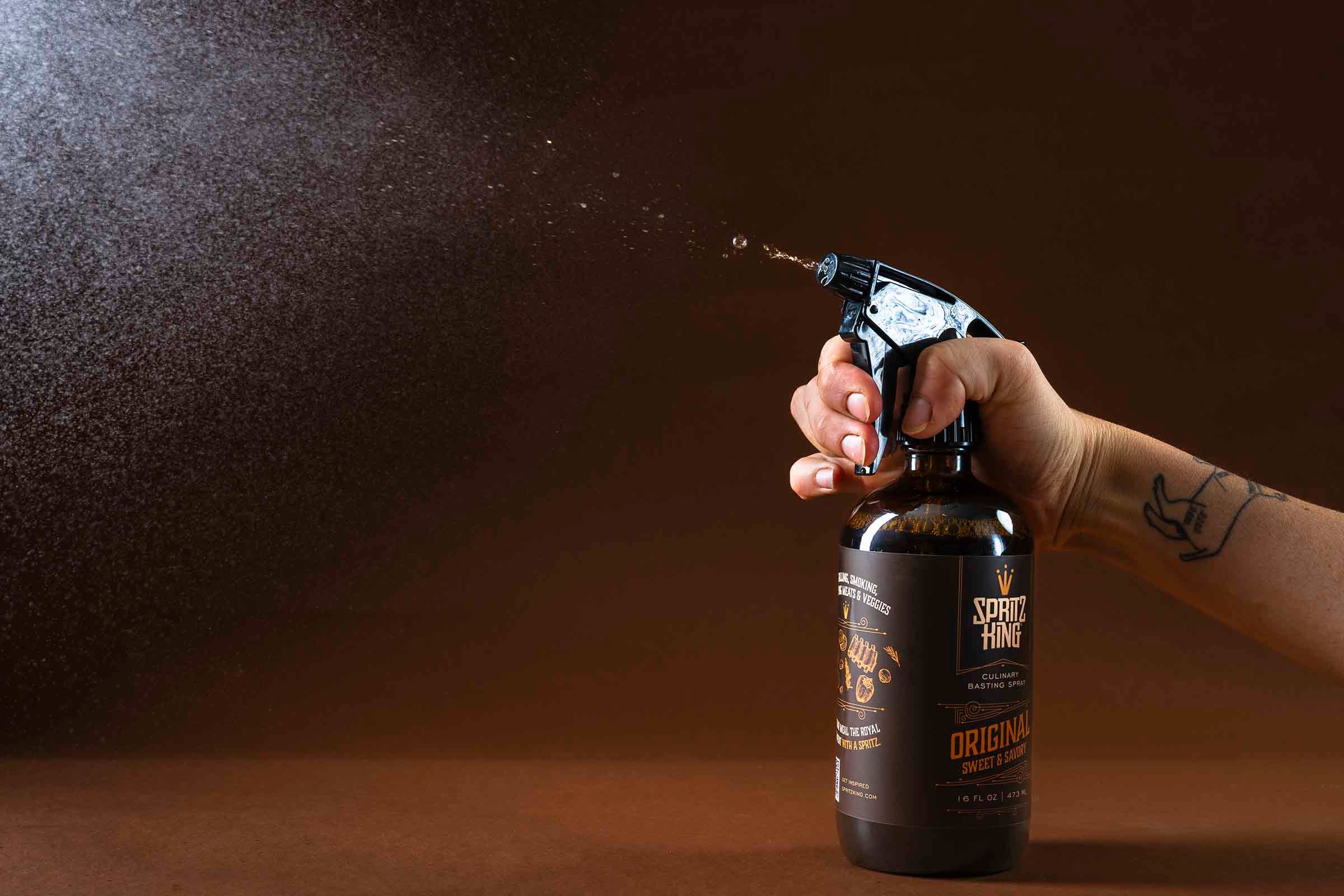
Choose the Right Sprayer
A standard spray bottle will work, but make sure it can produce a fine mist rather than a heavy stream. This ensures the spritz is evenly distributed and won’t saturate the meat too much. Spritz King’s spray bottle not only contains a proven spritz recipe delivering the best finished product, but also contains an adjustable spray nozzle to help deliver the appropriate spray type for the type of cooking performed.
Don't Over-Spritz
The goal is to mist, not soak the meat. Over-spritzing can cause the seasoning or bark to become soggy, which may hinder the desired texture. Light and frequent spritzes are key.
Spray from a Distance
Hold the sprayer around 8 to 12 inches away from the meat to avoid disrupting the surface too much.
Maintain Temperature
Try to avoid opening the smoker or grill too often, as this can lead to temperature fluctuations. Be efficient with your spritzing so that the cook is minimally interrupted.
Other Considerations
The cooking environment has a significant impact on how spritzing will affect your food. For example, in a fast-cooking environment such as an air fryer, you will want to spritz in the beginning stages, perhaps once during the cook by pausing your fryer and then again towards the end depending on cook time. Much of it comes down to personal preference, but over-spritzing may result in soggy food.
Use of a Spritz While Using Wood Pellets
Using different wood chips in a smoker imparts distinct flavors, with each wood type contributing unique aromas such as fruity, smoky, or savory notes. When applying a spritz during the smoking process, the moisture helps to enhance these flavors by promoting a more even absorption into the meat, adding complexity to the overall taste. Furthermore, the sticky layer of sugars help create smoke stick and enhance the smoke ring within your meats resulting in outstandingly smoky flavors that seal in the flavors.
Importance of Maintaining Balance: When and How Often to Spritz
Maintaining balance while barbecuing is crucial for achieving the perfect flavor and texture, especially when it comes to spritzing. Spritzing adds moisture to the meat and helps enhance its flavor, but timing is key. Too frequent spritzing can prevent the formation of a good bark, the flavorful outer layer that develops during cooking. On the other hand, spritzing too infrequently can lead to dryness. It’s important to strike a balance by spritzing at the right moments—typically when the surface starts to look dry or after significant periods of cooking—to keep the meat moist without compromising the crust's texture.
Spritzing Tools: What You Need
If you are not using Spritz King to get the best spritz from the spritz experts, you will need the following:
- Spray bottles: When looking for a spray bottle to apply a spritz solution to cooked meats, choose one with a fine mist nozzle to ensure even coverage without soaking the meat. Additionally, consider a bottle that is made of food-safe, durable materials, resistant to corrosion from acidic ingredients in the spritz solution.
- If you don't have a spray bottle for applying a meat spritz, you can use a basting brush or a spoon to gently coat the meat with the liquid. Another option is to pour the spritz into a small bowl and use a cloth or paper towel to dab it onto the meat.
- Your key ingredients. Make sure you use a combination of sweet and savory and don’t overwhelm with one or the other. Again, maintaining balance is key and the right ratios of amino acids and sugars are essential to ensure the best outcomes.
Spritzing Vegetables: An Underrated Technique
Spritzing vegetables while cooking helps maintain moisture, preventing them from drying out and ensuring they cook evenly. It also allows for better heat distribution, enhancing flavor absorption and promoting a tender, crisp texture.
Boosting vegetable caramelization with sweet spritzes like honey-water blends or using a balsamic vinegar or pineapple/apply juice combined with tamari or soy sauce makes a great spritz.
Enhancing smokiness in vegetables with infused liquids (smoked paprika, chipotle or chili oil in water) will give your veggies a boost.
Spritzing creates layers of flavor by spritzing before and midway through the grilling process.
Spritzing Using Different Cooking Methods
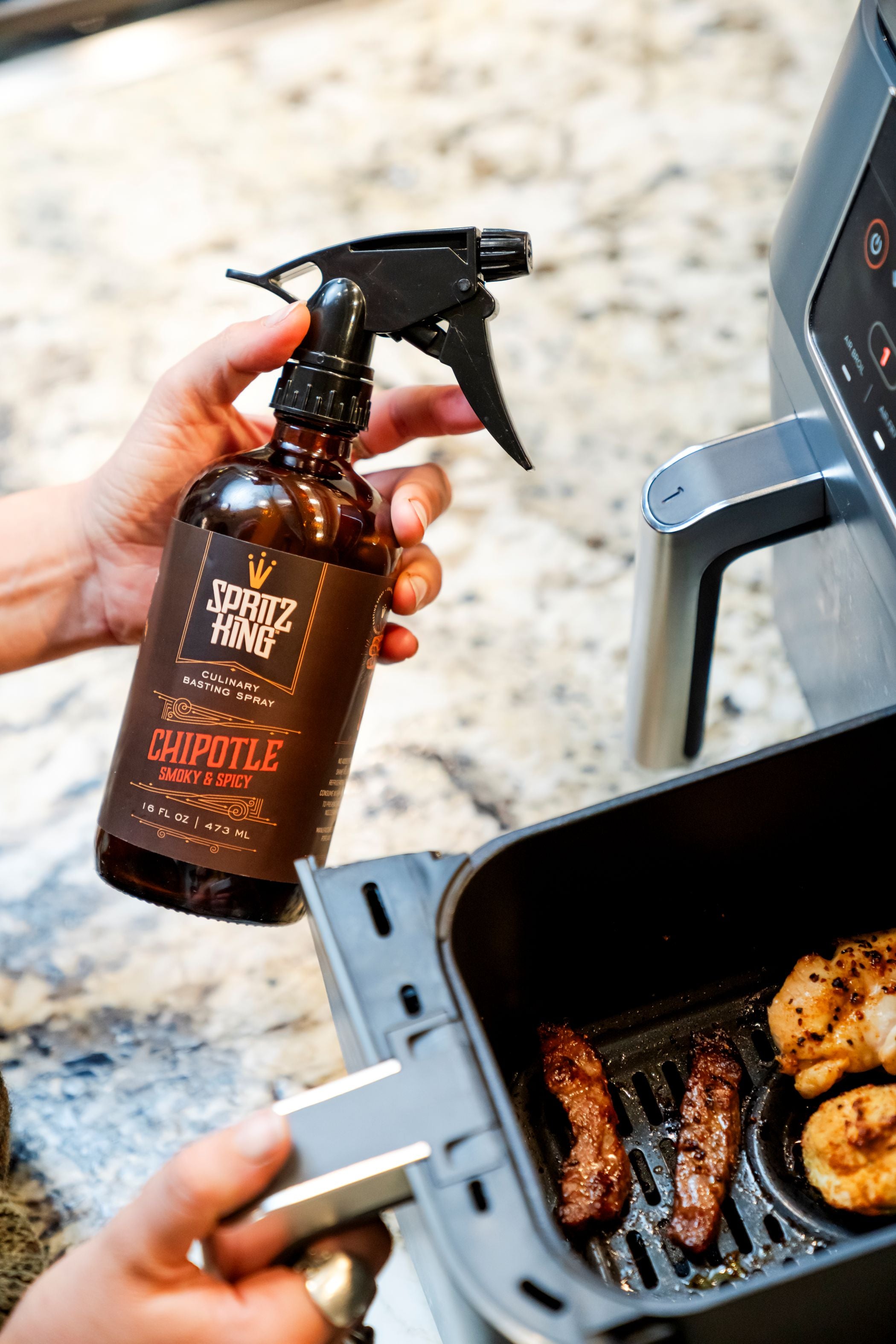
Spritzing When Cooking With An Air Fryer
Spritzing food while cooking in an air fryer can enhance texture and flavor by promoting even browning and crispiness. The best time to spritz is typically after you’ve preheated the air fryer and just before you add your food. You can lightly spray or spritz a thin layer of oil on the food's surface to help it crisp up without soaking it. If you're cooking something like fries, chicken wings, or breaded items, it's often helpful to spritz halfway through the cooking process, especially if the food is looking dry or if you want to increase the crispiness. Just be sure not to over-spritz, as excess oil can cause uneven cooking or result in a greasy finish. Always use an oil sprayer or mister for a fine, even coating, and opt for oils with high smoke points, like avocado or canola oil, to avoid burning.
Spritzing When Using a Smoker
Spritzing is a technique used when smoking meat on a smoker, such as a Traeger, to maintain moisture and enhance flavor during the cooking process. It typically involves spraying a liquid—like apple cider vinegar, apple juice, or a marinade—onto the meat at regular intervals. This helps keep the surface moist, promotes the development of a flavorful bark, and can add an extra layer of taste. The best time to start spritzing is after the meat has formed a nice bark, usually around the 2- to 3-hour mark, depending on the cut and cooking temperature. From there, you can spritz every 30 to 60 minutes. However, it’s important not to overdo it, as too much moisture can prevent the bark from forming properly. Spritzing is most effective in the later stages of cooking, particularly during the "smoke" phase, once the meat has absorbed enough smoke flavor and is nearing tenderness. This technique can be adjusted based on the type of meat and your flavor preferences.
Spritzing When Using a Green Egg or Similar Grill
Spritzing when cooking with a Big Green Egg is a technique used to add moisture and enhance flavor during the cooking process, especially for low and slow cooks like brisket or pork shoulder. Using a spray bottle filled with a liquid—such as water, apple cider vinegar, or a marinade—helps maintain the meat’s moisture, prevents it from drying out, and can even help build a flavorful bark on the outside. Spritzing every 30-45 minutes during the cook can also create a glossy, caramelized crust as the meat absorbs the moisture and flavors.
Popular Spritzing Liquids for Meat
Vinegar-based options (e.g., apple cider vinegar) for brisket and pork.
Stock or broth for added depth (beef or chicken).
Citrus-based options (lemon, orange) for a zesty flavor profile.
Herbal infusions (e.g., thyme or rosemary in water) for added complexity.
Dairy or creamy liquids (like buttermilk) for certain grilling styles or cuisines.
Juices (apple, pineapple) for sweetness and caramelization.
Alcoholic beverages (beer, wine) for complex flavor profiles.
Specialty or Commercial Spritzes: You can make a custom spritz using combinations of the above liquids, adding spices and herbs or simply buy a tried and tested professional spritz like Spritz King that will ensure the best outcomes.
Spritzing Recipes for Meat & Vegetables
Classic Apple Cider Vinegar Spritz
- 1 cup apple cider vinegar
- 1 cup water
- 1 tablespoon brown sugar (optional)
This simple and tangy spritz is perfect for pork shoulder, ribs, and other cuts of pork. The acidity helps cut through the richness of the meat.
Apple Juice and Water Spritz
- 1 cup apple juice
- 1 cup water
- 1 teaspoon cinnamon (optional)
This is a popular choice for chicken, turkey, or pork. The sweet apple juice adds a subtle sweetness while the cinnamon adds warmth.
Beer and Beef Broth Spritz
- 1 cup beer (preferably a light lager or pale ale)
- 1 cup beef broth
Great for beef brisket, this spritz adds maltiness from the beer and a savory depth from the beef broth.
Citrus Herb Spritz
- 1 cup water
- 1/2 cup orange juice
- 1 tablespoon lemon zest
- 1 sprig fresh rosemary
Perfect for chicken, turkey, or fish, this spritz infuses the meat with a zesty, fresh flavor profile.
Spritz King Recipe
Try a commercialized spritz like Spritz King and leave the guessing behind. Spritz King was developed by a grilling afficionado but refined in a commercial kitchen by food scientists to maximize flavor, shelf stability and bark/exterior optimization through the proper ratios of ingredients.
It’s perfect for all meats and veggies!
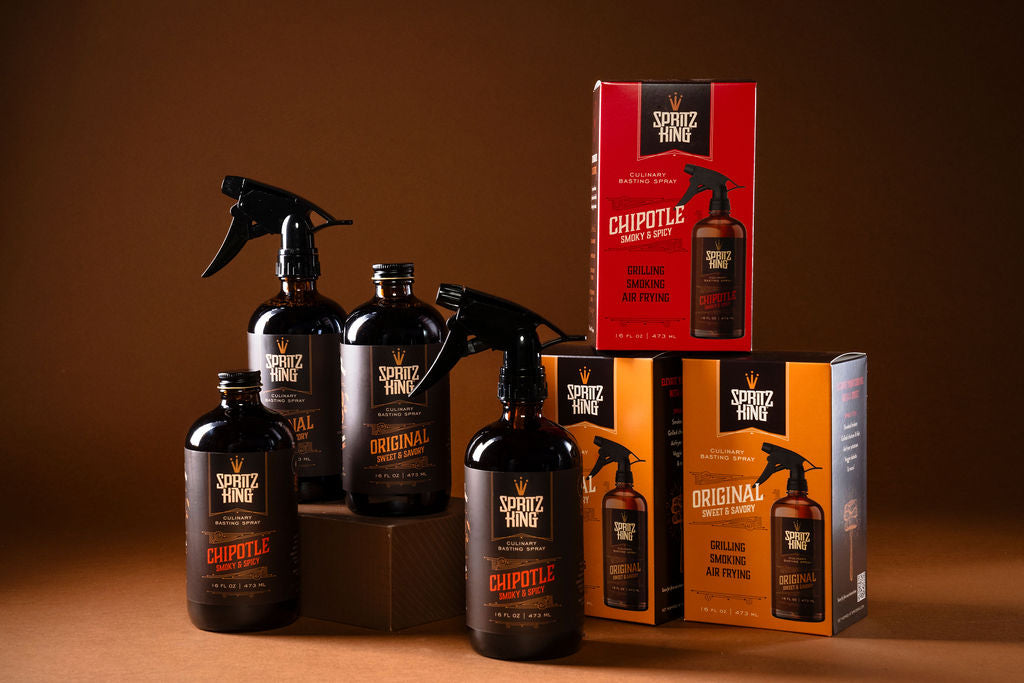
Common Mistakes to Avoid When Spritzing Food
Spraying Too Much: It’s easy to get carried away, but avoid oversaturating the meat. A light mist is more effective than drenching the surface.
Spritzing Too Often: You don’t need to spritz every few minutes. Give the meat time to cook and develop flavor between spritzes.
Using the Wrong Liquids: Avoid sugary liquids like soda or syrup. These can cause the meat to burn or overly caramelize. Spritz King has developed the ultimate ratio of amino acids to sugars to ensure burning and over-caramelization doesn’t occur.
Spritzing Before the Rub Sets: If you spritz too early, you might wash off your seasoning or rub. When applying rubs to meats, it's important to do so before spritzing, as the rub needs to adhere to the meat's surface. Typically, you should apply the dry rub 30 to 60 minutes before cooking to allow the flavors to settle into the meat. Wait until the meat has had a chance to absorb some heat and form a dry surface layer before applying any spritz. Spritz King can also act as a binder and as a best practice, it is common, especially for frozen foods being cooked in air fryer or overly dry meats, to spritz in advance so the liquid can act as a binder and help your rubs and spices stick and be absorbed. Spritzing, which we recommend being done during the cooking process, can help maintain moisture and enhance the flavor of the rub by preventing it from drying out, but should be done sparingly so as not to wash away the seasoning.
Failing to Taste and Refine Your Spritz Solution: Like anything else, it’s best practice to taste your spritz and ensure the ratios of the sugars and umami (glutamates) are in balance. Spritz King’s extensive research takes the guessing game out of the equation and leaves you to focus on other aspects of the cooking process.
Other Advanced Tips for Spritzing
Experiment with Custom Spritzes or Spritz King: Feel free to create and add your own ingredients such as hot sauce, mustard, or Worcestershire sauce or your favorite beer or red wine.
Consider the Weather: In cold or windy conditions, you may need to spritz more often to prevent drying out, as the environment can sap moisture from the meat. Similarly, cooler temperatures during a long smoker type cooking process can increase the necessity for a longer cook time thereby requiring more spritzing.
Spritzing in a Wrapped Cook: If you're wrapping the meat in foil or butcher paper (like with the Texas Crutch), don’t spritz it right before wrapping, as it could dilute the seasoning. You can spritz when unwrapping for a fresh layer of moisture.
Where and What to Spritz: Spritzing can enhance the flavor and texture of a multitude of foods prepared in a myriad of cooking methods. Consider spritzing meats and veggies alike in your air fryer or convection oven? Spritzing can add flavor and seal in moisture in almost every food. Spritz King was developed to be used in a myriad of cooking methods, but also tastes great as a food topper in salads, pan fried chicken, bowls and more.
Conclusion: Spritzing Elevates Your Food
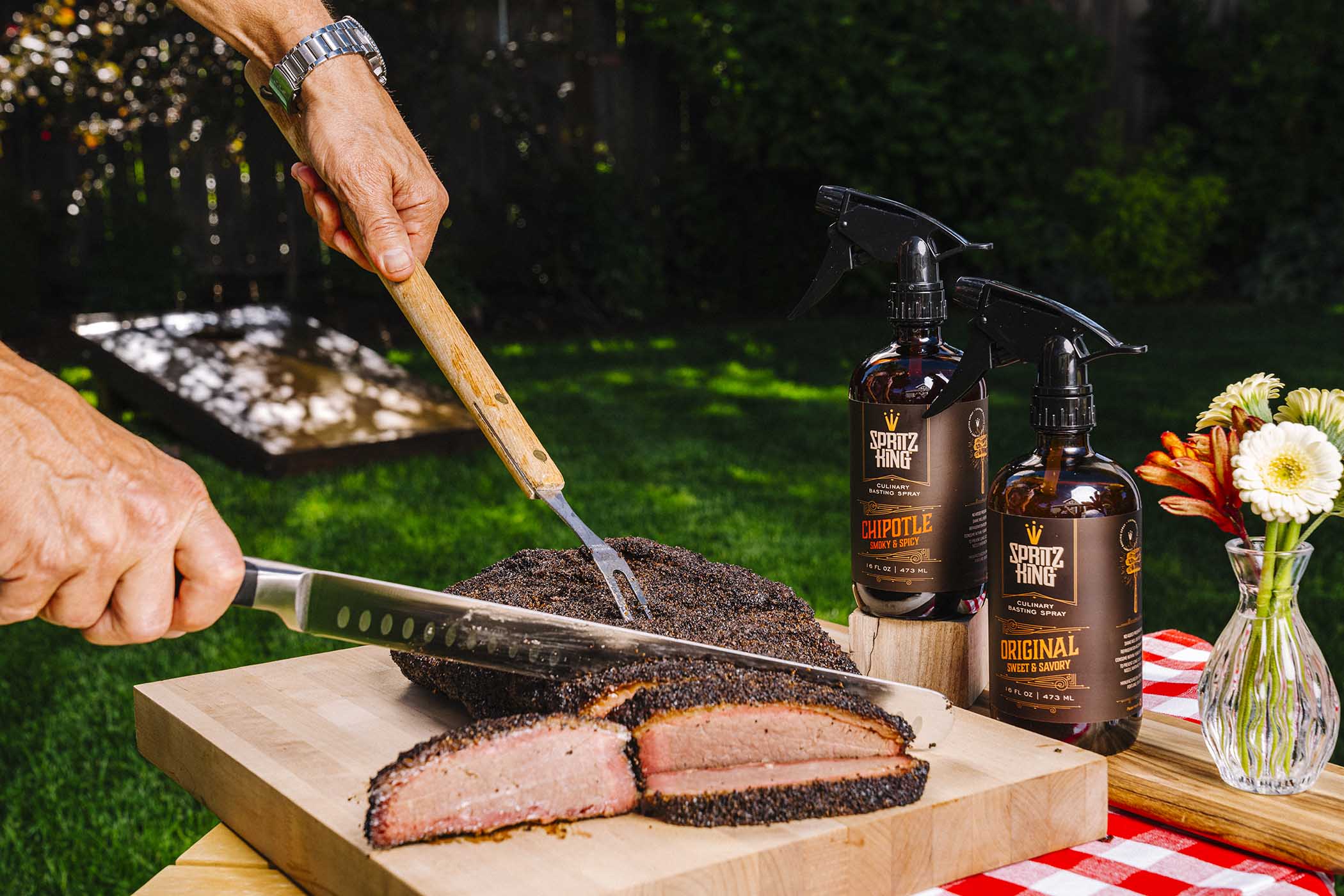
In conclusion, spritzing is a versatile and valuable technique that elevates the flavor, texture, and overall presentation of a wide range of dishes. Whether you're grilling, roasting, baking, or even sautéing, the gentle mist of oil, vinegar, or aromatic liquids can help achieve a more even cook, enhance browning, and infuse foods with subtle layers of flavor. This technique not only provides a healthier alternative to traditional oiling methods but also offers control over the amount of seasoning or fat being applied, making it easier to create dishes that are flavorful yet balanced.
To achieve the best results, it’s important to use the right sprayer and liquid for the job. A high-quality spray bottle ensures an even mist that won’t drench your food, and choosing the right mixture—whether it’s olive oil, flavored oils, or citrus-based sprays—can enhance the flavor profile you’re aiming for. When spritzing, consistency is key; avoid over-spraying, which can lead to soggy surfaces, and experiment with different techniques such as misting during cooking to keep food moist or as a final touch to add gloss and visual appeal. Remember, spritzing should complement, not overpower, the dish.
With a little practice, spritzing can become a go-to method for creating show-stopping meals that are both visually stunning and packed with flavor. From crispy roasted vegetables to perfectly seared meats, spritzing offers an easy way to improve texture, boost flavor, and even prevent sticking or burning. Whether you're cooking for yourself or impressing guests, spritzing allows you to fine-tune your dishes, ensuring they are both delicious and aesthetically appealing. Embrace the versatility of spritzing by doing it yourself or taking the guess work out of the perfect recipe by using Spritz King, and you'll quickly see how this simple technique can take your cooking to the next level.
Spritzing Meat & Vegetables FAQ
Need a little more information? Send us your questions.
Does spritzing make meat more tender?
Spritzing meats with liquid during cooking helps to maintain moisture by creating a layer of steam that prevents the surface from drying out, resulting in a juicier and more tender texture.
How often should you spritz during cooking?
The frequency of spritzing food during cooking depends on the dish and the desired effect. For grilling or roasting, spritzing every 15 to 30 minutes helps keep the food moist and promotes even cooking, especially for meats like chicken or turkey. For dishes like roasted vegetables, occasional spritzing with oil or a marinade can enhance flavor and prevent dryness. However, it's important not to overdo it, as too much liquid can affect the texture or cooking time.
What is the Maillard Reaction?
The Maillard reaction is responsible for the flavorful browning that occurs when you cook food over high heat. During this process, sugars and proteins react to caramelize the outside and seal in moisture on the inside. If you’re cooking meat, the result is a dark, crusty bark, a moist interior, and tons of flavor. Spritz King's simple but powerful ingredients help the Maillard reaction along.
What’s the ideal spritz-to-cook ratio for maintaining moisture without oversaturation?
The ideal spritz-to-cook ratio is about 1-2 tablespoons of liquid per 10-15 minutes of cooking time.
However, this varies depending on:
- Type of dish: Lighter foods like poultry and fish may need a lighter spritz, while denser items like roasts or vegetables might require a more generous application.
- Cooking method: For grilling or roasting, a light spritz every 10-15 minutes can help maintain moisture, while slow-cooking may not require as much spraying.
- Liquid type: Oils and broths will provide moisture and flavor without compromising texture, while water can help retain moisture but may not add as much flavor. Avoid using overly acidic liquids unless they're part of the recipe.
To avoid oversaturation: Remember to spray from a distance, use a light mist and always consider timing.
Can you skip spritzing and still achieve great results?
Yes, it’s absolutely possible to achieve great cooking results without spritzing, especially when using techniques like roasting, grilling, or braising, where moisture can be controlled naturally. While spritzing can help with certain dishes—like ensuring a crispy bark on smoked meats—it's not essential for good flavor or texture. Proper seasoning, cooking temperature, and time management are usually enough to create delicious results.
Does spritzing ruin bark?
Spritzing while smoking meats can soften the bark by adding moisture to the surface, potentially interfering with the formation of a thick, crispy crust, but when done strategically, it can enhance flavor and tenderness without ruining the bark.
When should I start spritzing my ribs?
The optimal time to spritz ribs when smoking or barbecuing is around every 45-60 minutes during the cooking process, starting after the first hour. Use a mixture of apple juice, cider vinegar, or a similar liquid to keep the ribs moist and enhance flavor without overpowering the smoke, ensuring a balanced crust and tender texture by the end of cooking.
Natural Sugars from Fruit
The perfect amount of natural sugar ensures an optimal level of browning.
Meat or Veggies
The sugars are applied to proteins found in meats and vegetables.
High Heat Source
High heat kicks off a reaction between the sugars and proteins.
Tasty Results
The combination equals perfectly browned, juicy, and flavorful food.
